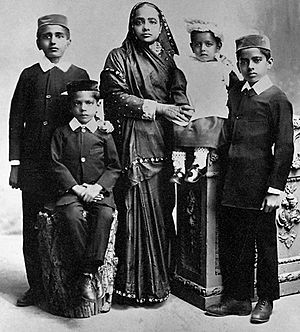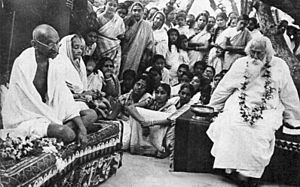Kasturba Gandhi facts for kids
Quick facts for kids
Kasturba Gandhi
|
|
|---|---|
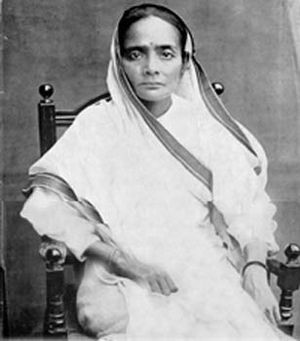
Gandhi in 1915
|
|
| Born |
Kasturbai Gokuldas Kapadia
11 April 1869 Porbandar, Porbandar State, Kathiawar Agency, British Raj
|
| Died | 22 February 1944 (aged 74) Aga Khan Palace, Pune, Bombay Presidency, British India (now Maharashtra, India)
|
| Other names | Kasturba Mohandas Gandhi Kasturba Gokuldas Kapadia |
| Occupation | Activist |
| Spouse(s) | |
| Children |
|
Kasturbai Mohandas Gandhi (born Kasturbai Gokuldas Kapadia; 11 April 1869 – 22 February 1944) was an important Indian activist. She played a key role in the Indian independence movement when India was under British rule. She was married to Mohandas Gandhi, who is famously known as Mahatma Gandhi. In India, National Safe Motherhood Day is celebrated every year on April 11, which is Kasturbai's birthday.
Contents
Early Life and Family
Kasturbai was born on April 11, 1869. Her parents were Gokuladas Kapadia and Vrajkunwerba Kapadia. Her family were Hindu tradesmen from the coastal town of Porbandar.
In May 1883, when Kasturbai was 14 years old, she married 13-year-old Mohandas. Their marriage was arranged by their parents, which was a common tradition at the time. Mohandas later said that for them, marriage meant "only wearing new clothes, eating sweets and playing with relatives."
After their wedding, Kasturbai spent the first few years at her parents' home, as was the custom. Kasturbai and Mohandas had four sons who grew up: Harilal, Manilal, Ramdas, and Devdas.
In 1888, Mohandas went to London to study, and Kasturbai stayed in India. In 1896, she and their two sons joined him in South Africa. Later, in 1906, Mohandas decided to live a life of self-control, called brahmacharya. Some people thought this might have been difficult for Kasturbai as a traditional Hindu wife. However, she remained a strong supporter of her husband and his work.
Political Work and Activism
Kasturba Gandhi first became involved in politics in South Africa in 1904. She helped her husband and others set up the Phoenix Settlement near Durban. In 1913, she joined protests against the unfair treatment of Indian immigrants in South Africa. Because of her activism, she was arrested and sentenced to hard labor on September 23, 1913. While in prison, she encouraged other women to pray and taught those who couldn't read or write.
In July 1914, Gandhi and Mohandas left South Africa and returned to India. Even though Kasturba suffered from chronic bronchitis, she continued to take part in protests and civil actions across India. She often stepped in for her husband when he was in prison. She spent most of her time helping and serving in ashrams (spiritual communities). In these ashrams, Kasturba was lovingly called "Ba," which means "Mother," because she cared for everyone there.
In 1917, Kasturba worked to improve the lives of women in Champaran, Bihar. Her husband was working with indigo farmers there. She taught women about hygiene, health, and how to read and write. In 1922, she joined a Satyagraha (nonviolent resistance) movement in Borsad, Gujarat, even though she was not in good health.
She did not participate in Gandhi's famous Salt March in 1930. However, she continued to join many other civil disobedience campaigns and marches. This led to her being arrested and jailed many times.
In 1939, Kasturba took part in nonviolent protests against British rule in Rajkot. Women in the city had specifically asked her to speak up for them. She was arrested again and held alone for a month. Her health got worse, but she kept fighting for India's independence. In 1942, she was arrested once more, along with Mohandas and other freedom fighters, for being part of the Quit India movement. She was imprisoned in the Aga Khan Palace in Pune. By this time, her health had become very poor, and she passed away at the detention camp in Pune.
Health and Passing Away
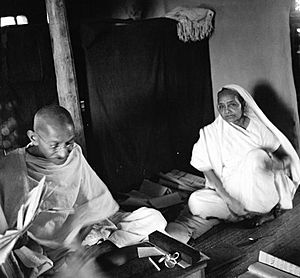

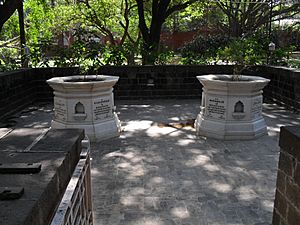
Kasturba suffered from chronic bronchitis. Her condition was made worse by pneumonia. In January 1908, her health got much worse when she fasted while her husband was in prison. She became very ill. She later had to have a major surgery.
In January 1944, Kasturba had two heart attacks. After this, she was mostly confined to her bed. She had trouble breathing, which made it hard to sleep at night. She asked to see an Ayurvedic doctor, which is a traditional Indian form of treatment. After some delays, the government allowed a specialist in traditional Indian medicine to treat her. At first, she seemed to get better. By the second week of February, she was well enough to sit on the veranda in a wheelchair for short periods and talk. But then she got worse again.
She passed away at the Aga Khan Palace in Pune on February 22, 1944, at the age of 74.
The Kasturba Gandhi National Memorial Trust Fund was created in her memory. Mohandas asked that this fund be used to help women and children in villages across India.
Legacy and Recognition
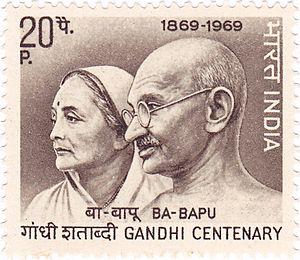
Many places and institutions are named after Kasturba Gandhi to honor her contributions:
- Kasturba Gandhi College for Women
- Kasturba Hospital (Wardha)
- Kasturba Hospital (Valsad)
- Kasturba Medical College, Manipal
- Kasturba Nagar railway station
- Kasturba Gandhi Balika Vidyalaya
- Kasturba Nagar (Delhi Assembly constituency)
- Kasturba Gandhi National Memorial Trust
- Kasturba Health Society
- Kasturba Nagar, Chennai
- Kasturba Nagar, Puducherry
- Kasturba College for Women, Villianur, Puducherry
- Kasturba Road
- Kasturba Gandhi Marg, New Delhi.
- Kasturba Nagar, Kochi.
- Kasturba Nagar, Bhopal.
Images for kids
-
Mohandas K. Gandhi and Kasturbai Gandhi at Eternal Gandhi Multimedia Museum, Gandhi Smriti (Birla House), Tees January Marg, New Delhi.
See also
See also
 In Spanish: Kasturba Gandhi para niños
In Spanish: Kasturba Gandhi para niños


